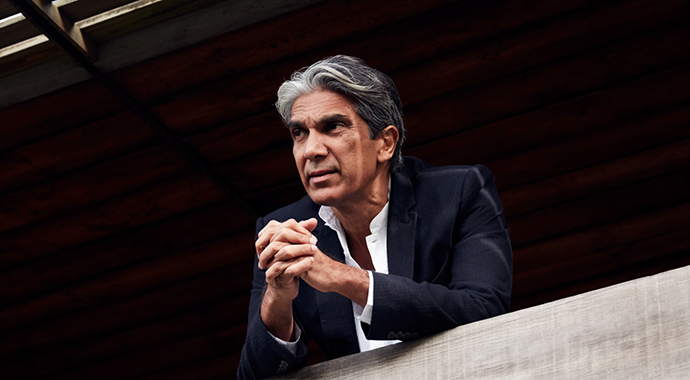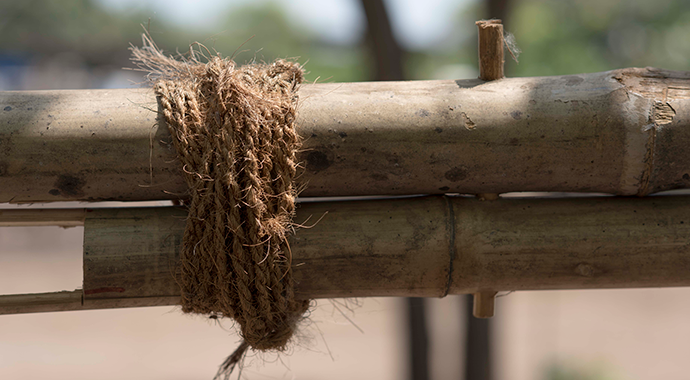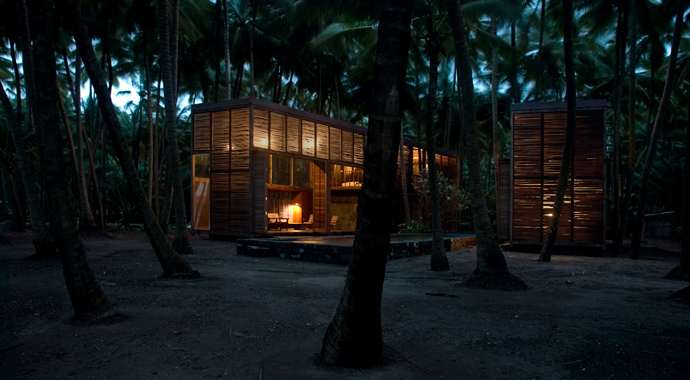Bijoy Jain creates places of meaning

Now in its third year, MPavilion returns to Melbourne’s Queen Victoria Gardens between October 2016 and February 2017, with a new design by renowned Indian architect Bijoy Jain of Studio Mumbai. Using a vastly different material palette to previous iterations by Sean Godsell and Amanda Levete, the 2016–17 pavilion is an extension of Jain’s ongoing interest in traditional craftsmanship and human connectedness to the landscape. We caught up with Jain during his recent trip to Melbourne to unearth the story behind the structure.
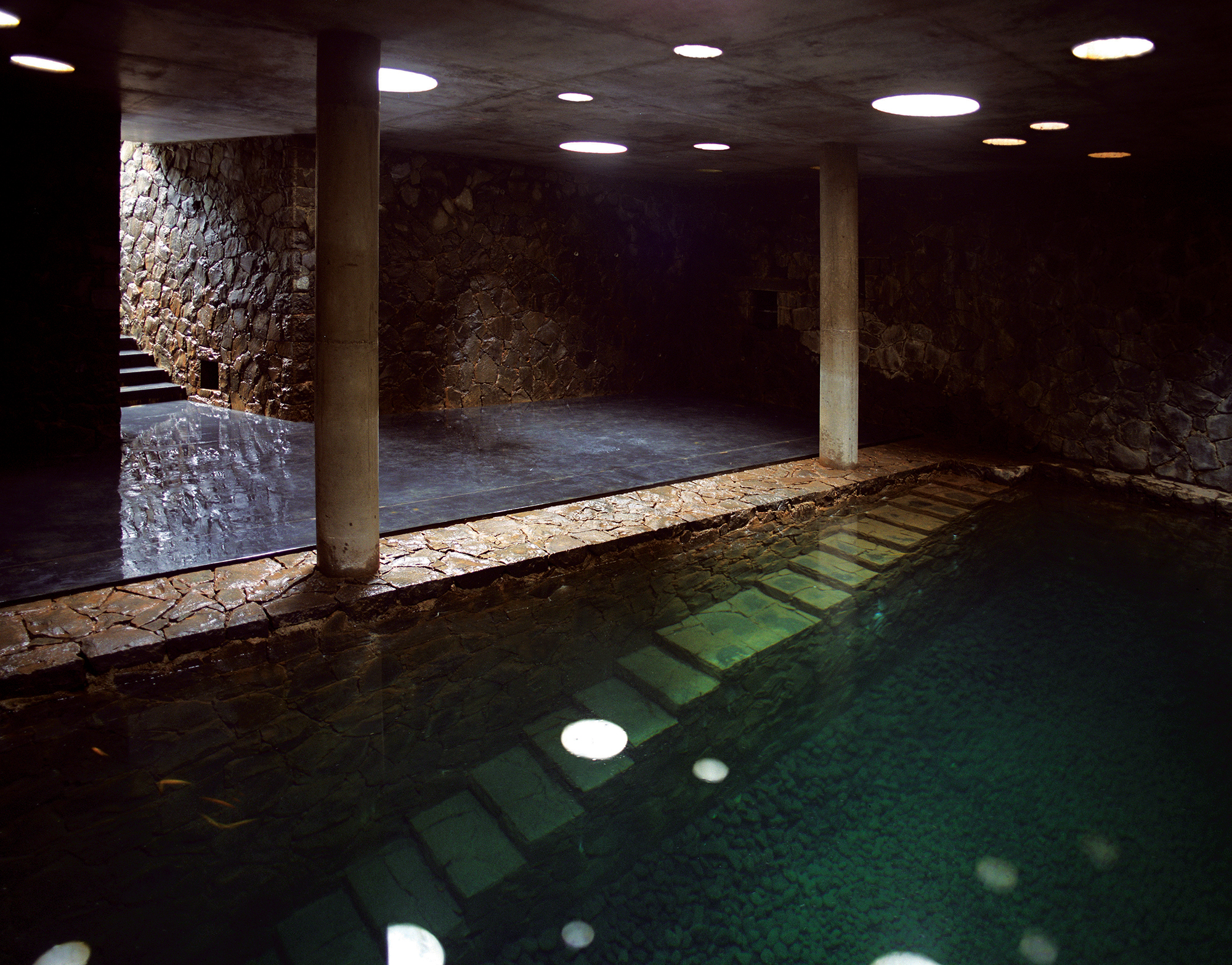
It’s not uncommon to hear Bijoy Jain describe the different elements of his architectural projects as if they are parts of the human body. Underneath his Tara House (2005) – a wood-framed beachside home in the North Konkan region of Maharashtra, India, overlooking the Arabian Sea – a hidden stone chamber, or “belly button” as Jain would say, is the subterranean heart of the structure. Filled with water derived from an aquifer, the underground room is intended as a refuge from the hot sun; circular airholes admit beams of light and the sounds of the sea to permeate, and the water level falls and rises in tandem with the natural tide. When it rains, as it often does in Maharashtra’s tropical climate, water from the roof of the house percolates into the well, replenishing the aquifer and providing a constant source of water for the house and surrounding gardens.
This empathy for the landscape has characterised Jain’s work since the inception of his practice, Studio Mumbai, in 1995. Similar to the Tara House, his Palmyra House (2007) is designed with particular attention to its relationship with the surrounding environment, with the louvred exterior crafted from the outer parts of the palmyra trunk (a local palm species) and its skeletal framing made from ain, a local hardwood. Situated within a coconut grove in Nandgaon (also in Maharashtra), the two structures that form the house were configured in a manner intended to preserve as many of the surrounding trees as possible.

It’s apt, then, that I meet with Jain during his recent visit to Melbourne at the Walsh Street House, designed by Robin Boyd in 1958 and now lovingly preserved as the Robin Boyd Foundation’s headquarters. Central to the design of the Walsh Street House is its division into two volumes (the main house and the children’s quarters), its orientation towards an internal courtyard and the preservation of a large Monterey pine in the front garden, around which Boyd designed the house. Without wanting to needlessly conflate the two, Boyd and Jain’s affection for nature is mutual. In his famous attack on featurism, The Australian Ugliness (1960), Boyd considers two distinct trends in the history of architecture: “buildings which gently lay down with nature and buildings which proudly stood up in contrast”. Unmistakably, Jain’s work is of the former category. (And then there is featurism: “neither sympathetic nor challenging, but evasive, a nervous architectural chattering avoiding any mention of the landscape”.)

Jain’s connection to modernist ideology is no coincidence. Born in 1965, he grew up in Juhu on the coast of India near Mumbai, before moving to the United States to study architecture at Washington University, St. Louis. Later, he moved to Los Angeles, where he worked in the model shop of modernist figurehead and 1984 Pritzker Prizewinner Richard Meier, making models for the Getty Museum (arguably the project responsible for propelling Meier into the mainstream), while studying under Studio Works founder Robert Mangurian. After a stint in London, Jain returned to India in 1995 to establish Studio Mumbai, where he went on to cultivate a craft-centred way of working, encouraging the environmentally sensitive designs he’s known for today.
With a focus on local building techniques, materials, knowledge and ingenuity, Studio Mumbai’s projects are conceived through an elaborate process of model-making, sketches and comprehensive consideration of the immediate landscape. At the 12th Venice Architecture Biennale in 2010, Studio Mumbai’s installation Work-Place earned a special jury mention for its insight into the studio’s collaborative approach of learning through making.
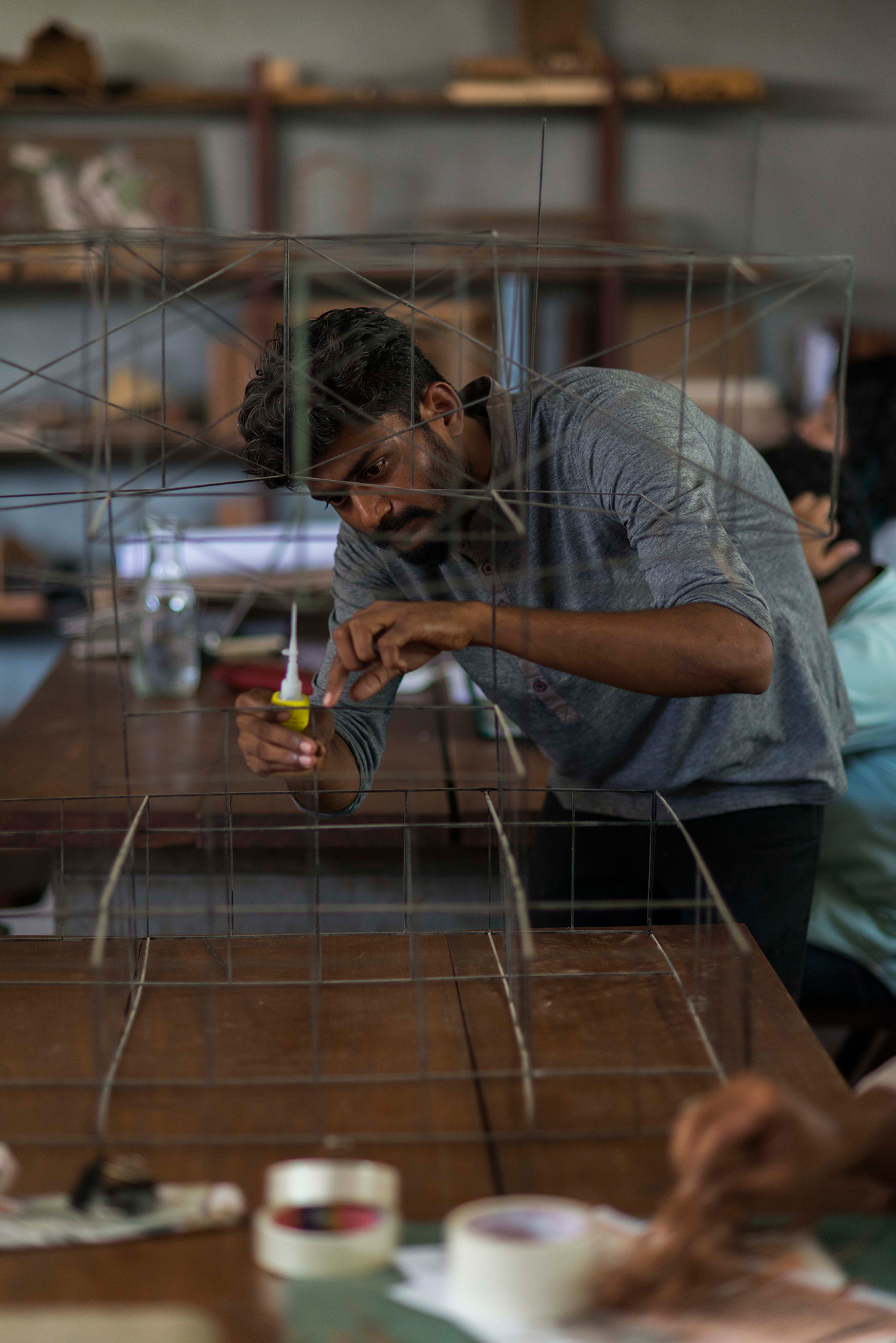
mock-ups, models, material studies, sketches and drawings. Photo courtesy of MPavilion and Studio
Mumbai.
Though clearly influenced by traditional craftsmanship, Jain situates his practice far from any kind of traditionalism. “I think there’s a great nostalgia in which I’m not interested at all,” says Jain of the potential of his work to look towards the future. “The idea of tradition for me is something that you carry forward – this is what’s important to me. I think we all have the potential – whether it’s a gardener nurturing a small plant, or an architect – to leave something behind that enables a culture we don’t even know yet, and to leave something that can be nourished, contained and held.”
It’s in this way that Jain has approached his design for the 2016–17 MPavilion in Melbourne. His will be the third iteration of the temporary architectural structure to take residence in the Queen Victoria Gardens over late spring and summer, following Amanda Levete’s fibreglass canopy of 2015–16 and Sean Godsell’s perforated aluminium shutters of the inaugural 2014–15 pavilion. But where Levete’s pavilion – now permanently located in Melbourne’s Docklands – was a hybrid of organic form and complex technology, Jain’s pavilion focuses on the handmade, with a distinctively terrestrial palette of bamboo, stone and rope. “It was important to me that the materials are organic – not so much for it to be what we consider ‘sustainable’, but so it can emerge from the ground and return back to the ground, like the human body,” he says.
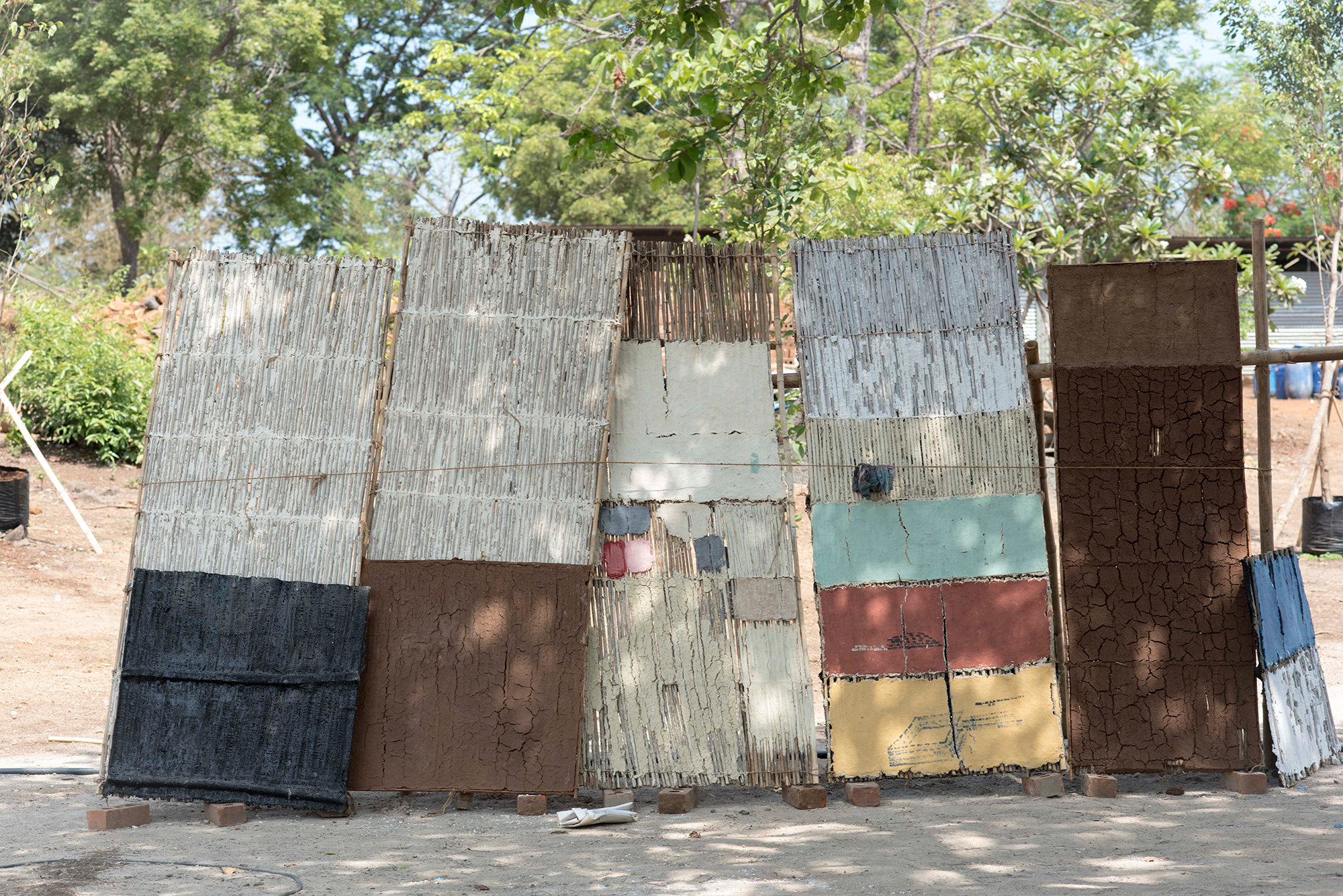

If Boyd was a ‘big-picture’ architect in his critical objective of situating Australian architecture within a broader, global framework, you could call Jain a ‘biggest-picture’ architect, conceptually zooming out so far as to consider humans and their built environment within a vast cosmological – even mythological – timeframe, in a way that somehow comes full circle and arrives back at a human scale. At his recent public lecture ‘Architecture and Lore’ at the Melbourne School of Design, he elaborated on his interests in the transmission of knowledge between people over generations. “There’s a lineage of carpentry and masonry, building with high skill and great efficiency that’s specific to India, and I am transferring that ideology to projects around the world,” he says.
I’m interested to know how Jain mediates between the local ingenuity and resourcefulness he draws on – no doubt a product of India’s complex sociopolitical and historical context – and his ideas of universal human creativity. Can ‘innate’ qualities like creativity really be divorced from the contexts in which they evolved? And, if so, where does that situate the ‘local’? Says Jain: “I think ‘local’ pertains to your immediate landscape or surroundings and the energy you can draw from that, but I also think the ‘local’ can be something universal. Whether in Melbourne, Mumbai or somewhere in Brazil, I think the same forces ultimately shape what we now call the ‘local’. I’m interested in the human expressions that can extend beyond these boundaries, and this idea that all humans fundamentally within us carry an aspect of self-expression.”

The day we meet is the day the MPavilion design is officially released, though a number of refinements are made over the month that follows. With a footprint of 16.8 × 16.8 square metres, the bamboo, stone and rope structure aims to explore concepts of handmade architecture and the craft of building at its most basic, says Jain. “All these materials carry an embodied energy, and that embodied energy can remain intact even as it evolves and takes different forms, before returning back to sit latent and perhaps re-emerging later in some other form.” In keeping with Jain’s proclivity for using local materials, the bluestone floor of the pavilion will be sourced from Victoria. Adjacent to the pavilion will stand what’s known as a ‘tazia’, a decorative structure used in traditional Indian ceremonies to denote the connection between the earth and the sky. Forgoing renders in favour of elaborate handmade models, Jain and his team of craftsmen have tested the design at their Mumbai workshop through a detailed series of models and full-scale prototypes.

The Naomi Milgrom Foundation, responsible for commissioning MPavilion each year, has always been upfront about its connection to London’s Serpentine Pavilion, which has seen leading architects from around the globe conceptualise its design since 2000. What differentiates MPavilion from its Serpentine counterpart, however, is the lengthy and ambitious program of events it hosts throughout its tenure. Where other architects may see the pavilion format as an excuse to delve into the sculptural, Jain considers his pavilion to obscure such simple categorisation: “Art, architecture, sculpture – it’s irrelevant. It’s about making space, and about making space where one can transmit knowledge, communicate and exchange ideas.”

For all the talk of context specificity and the localised resourcefulness that informs so much of Jain’s practice, it will be interesting to see how his MPavilion transpires in what he has called the “non-place” of the Queen Victoria Gardens, referring to its encirclement within a border of streets and roads. “The pavilion will be a place of meaning, but an agnostic universal space,” he says.“What’s important to me is not these divisions and differences we as humans continuously define ourselves by. I want to acknowledge these differences but at the same time provide a place that can transcend them, even if only for a brief moment in time.”
MPavilion launches its 2016 commission by Bijoy Jain and Studio Mumbai in Queen Victoria Gardens, Melbourne on 5 October. Running until 18 February 2017, this year’s program features talks, workshops, installations, music and more. While you’re enjoying the events hub in Studio Mumbai’s pavilion, be sure to pick up a copy of our latest print edition, ‘Future Local’. which celebrates and explores the importance of context in our future urban environments. Visit the MPavilion website for a full list of upcoming events (and stay tuned for more information about all the events we’ll be running there too!).

